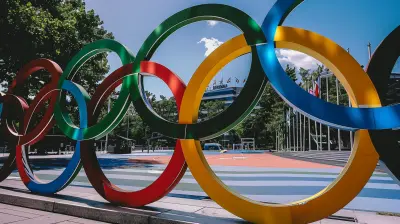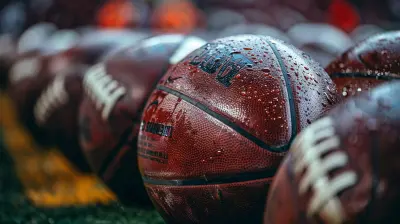The Role of Leadership in Successful Team Dynamics
12 June 2025
When you think of great sports teams—the kind that win championships, inspire fans, and set records—you often picture star athletes, last-minute game-winners, and jaw-dropping plays. But if you look a little deeper behind the scenes, there's something even more powerful at work: leadership.
Yep, leadership is the glue that holds a team together. It's the spark that turns a group of talented individuals into a well-oiled machine. Whether it's on the field, rink, court, or in the locker room, leadership plays a massive role in shaping team dynamics. So, let’s break it down. What exactly does leadership do for a team, and why should we care?
Why Team Dynamics Matter in Sports
Before we dive into leadership, let’s talk about team dynamics. In simplest terms, team dynamics are how people in a group interact, work together, and support one another.Picture this: You’ve got a team full of all-stars, but everyone’s playing for themselves. No one communicates, trust is nonexistent, and egos clash left and right. That team? Probably not going far.
Now flip the script. Say you've got a team with average players, but they work together seamlessly. They anticipate each other's moves, share the ball selflessly, and push one another to get better every day. That’s the magic of healthy team dynamics—and believe it or not, leadership is the engine driving that.
What Makes a Good Leader in Sports?
Let’s bust a myth right off the bat: leadership isn’t just about being loud, giving pep talks, or being the oldest player on the squad. Leadership takes many shapes and forms. A good sports leader inspires, supports, and drives the team forward—often in subtle but powerful ways.Here’s what makes a solid leader:
- Communication Skills
Great leaders are excellent communicators. They make sure everyone’s on the same page, both during the game and off the field.
- Empathy
Good leaders listen. They understand teammates' feelings, struggles, and motivations.
- Vision
Leaders see the big picture. They know the goal and help steer everyone in that direction.
- Consistency
No one follows someone who flips like a pancake. A leader shows up—mentally and physically—especially when it counts most.
- Accountability
When mistakes happen (and they do), leaders own up. No finger-pointing, no excuses.
Types of Leaders on a Team
Interesting thing about leadership? It doesn’t always wear a captain’s armband.Here are a few leadership roles that pop up naturally in team settings:
1. The Vocal Leader
This is your classic, front-and-center type. Think LeBron James or Tom Brady. They rally the group, lead huddles, and talk strategy nonstop.2. The Lead-by-Example Leader
Not big on words, but their actions speak volumes. They’re first in the gym, last to leave, and always giving 110%. Teammates naturally follow because they respect the grind.3. The Emotional Anchor
They’re the steady hand in the storm. When tempers flare or morale dips, they keep the vibe calm and positive.4. The Motivator
Rah-rah types who keep things light, crack jokes, and pump up the squad when the energy’s low. Every team needs one.5. The Strategist
This person might not even be the fastest or strongest, but they’re sharp. They read the game like a chessboard and always have a plan.Cool thing is, a team can (and should) have more than one type of leader. The magic happens when these roles sync up.
How Leadership Influences Team Performance
Alright, so we’ve got leaders in place—but how exactly do they impact performance?Building Trust and Confidence
Trust is the secret sauce of successful teams. When players trust one another—and their leaders—they’re willing to take risks, share the spotlight, and admit when they need help.Great leaders build that trust by showing vulnerability, staying humble, and backing their teammates through thick and thin.
Setting the Tone
Teams naturally reflect the tone set by their leaders. If your captain slacks off in practice, guess what? Others will too. If they show up fired-up and focused, that energy spreads like wildfire.Resolving Conflicts
Let’s be real: even the best teams have conflict. Ego clashes, miscommunications, and frustration are all part of the game. But a strong leader won’t let that stuff fester. They know when to step in, smooth things over, and refocus the group.Encouraging Growth
Leaders don’t just play to win—they help others get better. They cheer teammates on, offer constructive feedback, and celebrate progress no matter how small.Ever watch a vet pull a rookie aside during practice to teach a technique? That’s leadership in action.
Leadership from Coaches vs. Players
Both coaches and players can (and should) lead. But their roles are a little different.Coaches as Leaders
Coaches lay the foundation. They design the strategy, manage the roster, and build the culture. More than anything, they’re mentors.A good coach doesn’t just teach plays—they teach life skills. They know how to bring the best out of each player, adapt to personalities, and push the team forward.
Players as Leaders
Player leadership is more boots-on-the-ground. They’re the ones communicating mid-play, lifting teammates up after a mistake, and keeping morale strong inside the trenches of competition.When coaches and players are aligned in their leadership? That’s when the magic really happens.
Real-Life Examples of Great Leadership in Sports
Let’s look at a few all-time greats who defined leadership in their teams:Michael Jordan – Chicago Bulls
MJ wasn’t just about highlight-worthy dunks. He pushed his teammates relentlessly—sometimes too hard—but always with the goal of winning. His intensity was contagious, and it elevated everyone around him.Megan Rapinoe – USWNT
A vocal leader on and off the field, Rapinoe uses her platform to fight for equality and justice, building unity and meaning into everything her team does. Her leadership isn’t just about soccer—it’s about purpose.Derek Jeter – New York Yankees
“Captain Clutch” wasn’t flashy with words, but he led by example. Consistent, composed, and unshakably focused, Jeter was the calm in the storm—a true team-first guy.These athletes had different styles, personalities, and approaches—but they all shared one thing: They made people around them better.
Nurturing Leadership Within a Team
So how do you actually develop leaders on your team? You don’t just wait for someone to magically step up—you create the environment for leadership to grow.Here’s how:
- Encourage Communication: Let players speak up, share ideas, and lead small drills or meetings.
- Promote Accountability: Create a no-excuse culture that encourages taking responsibility.
- Foster Mentorship: Pair younger players with veterans—both grow in the process.
- Celebrate Leadership Moments: When someone shows leadership, call it out.
- Provide Growth Opportunities: Let players lead warm-ups, address the team, or even have input in decision-making.
The Ripple Effect of Good Leadership
When leadership is strong, it doesn’t just benefit the team. It affects the entire organization—coaches, staff, fans, and even the community.Strong team leadership creates:
- A culture of respect
- Better mental health and morale
- Higher performance levels
- Long-term success (not just a one-and-done win)
Leadership is about impact. And when you’ve got it flowing from every corner of a team, you’ve got the makings of something truly special.
Final Thoughts
At the end of the day, skills can win games—but leadership wins championships.Great leaders turn chaos into clarity, tension into trust, and effort into excellence. They don’t just show up—they lift everyone else up with them.
Whether you're a coach trying to build a winning culture, a player looking to step up, or just a fan curious about what makes great teams tick—never underestimate the role of leadership in successful team dynamics.
Because when the dust settles and the final buzzer sounds, it’s not just talent that gets remembered—it’s the legacy of leadership that lasts forever.
all images in this post were generated using AI tools
Category:
Team ManagementAuthor:

Onyx Frye
Discussion
rate this article
3 comments
Sylvia Lambert
Effective leadership is crucial in shaping successful team dynamics. Leaders foster communication, trust, and accountability, empowering team members to collaborate effectively. By setting a clear vision and promoting inclusivity, leadership not only enhances performance but also cultivates resilience, ultimately driving the team towards collective goals and success.
June 19, 2025 at 4:53 AM

Onyx Frye
Thank you for your insightful comment! I completely agree that effective leadership is essential for fostering communication, trust, and collaboration within teams, ultimately driving them toward success.
Lira Hurst
Great teams don’t just happen; they’re orchestrated by leaders who know how to play the game!
June 12, 2025 at 12:23 PM

Onyx Frye
Absolutely! Effective leadership is essential in shaping team dynamics and fostering collaboration, ultimately driving success.
Whitney Morrow
This article adeptly highlights how effective leadership shapes team dynamics, fostering collaboration and resilience. However, it could delve deeper into the nuances of different leadership styles and their impact on diverse team cultures. Understanding these subtleties is crucial for developing well-rounded, adaptable leaders in sports.
June 12, 2025 at 3:31 AM

Onyx Frye
Thank you for your insightful comment! I appreciate your suggestion to explore different leadership styles and their effects on team cultures. I’ll consider this for future discussions to provide a more comprehensive perspective.



